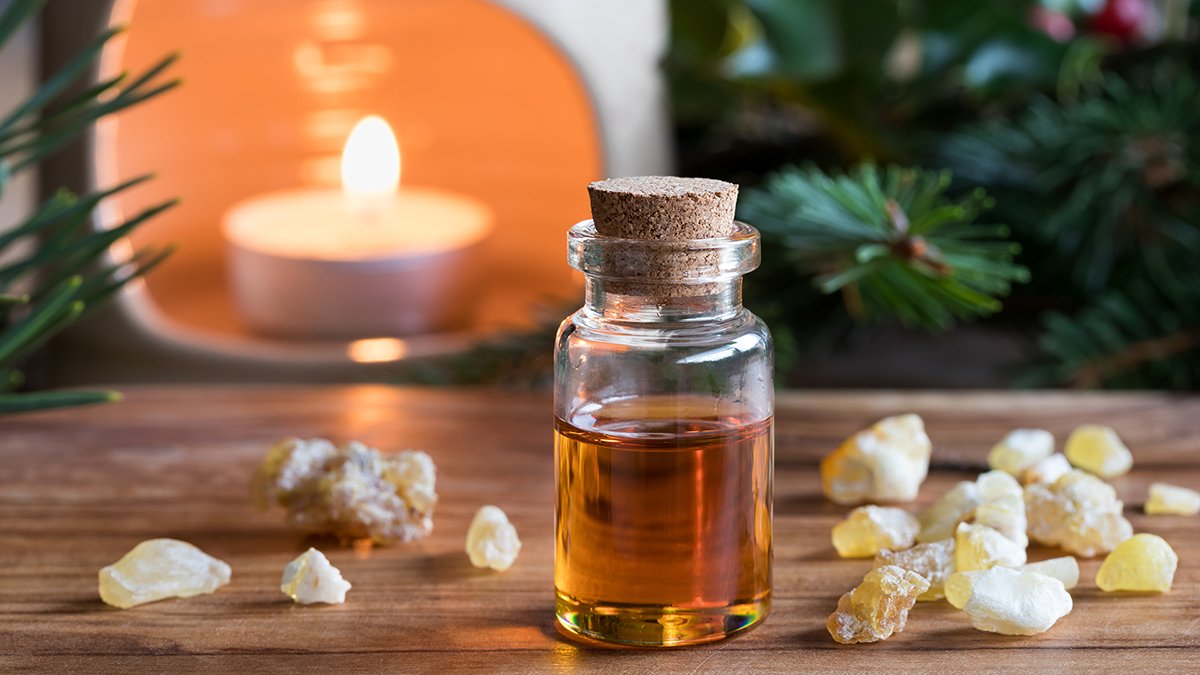Originating in the Arabian Peninsula, frankincense begins as the gummy sap harvested from Boswellia trees. Boswellia trees can grow in climates so harsh and unforgiving; they are known to grow without soil through solid rock.
Once Boswellia trees begin producing sap, they are carefully tapped three times per year. The bark of the tree is sliced to allow the sap to drain. As the sap seeps through the sliced bark, it hardens to form clusters of resin called tears. Once harvested, the dried resin tears can be burned as incense or steam distilled to create an essential oil. The English name for this aromatic resin is based in Old French. Franc encens translates as “high-quality incense.”
While frankincense may be best known for its use as a fragrance, our ancient ancestors clearly recognized the therapeutic potential of the Boswellia tree’s aromatic resin. Frankincense has been used throughout the ages as a treatment for numerous health concerns.
The Origins Of Frankincense
Frankincense has been used in the Arabian peninsula for more than 6000 years. Trading frankincense by land dates at least as far back as 1500BC. By 1000 BCE, Boswellia resin was being transported from harvesting centers in the Arabian Peninsula and northeastern Africa to Egypt, then by sea to India. As trade routes expanded, frankincense was distributed throughout the Old World, through Egypt, Babylon, Assyria, Persia, Greece, Rome, and China.
The kingdom of Southern Arabia became a key player within the global economy of the time. The market was unlimited. While expensive, frankincense was commonly considered a household necessity, a staple, used for everything from maintaining oral health to flavoring food.
Frankincense Was A Valued Commodity
For people living in the ancient world, the origin of frankincense was shrouded in mystery and intrigue. It was said that frankincense was harvested from trees grown in a treacherous mountain area, protected by disease-producing mist and venomous snakes that would leap into the air to attack anyone who dared approach.
At one time, frankincense was considered more valuable than gold and fueled the economy of the Arab world. Chinese, Latin, Greek, and Sanskrit sources provide testimony to how precious the commodity was. Ancient cultures used frankincense to treat a significant number of health concerns, including:
- Reducing fevers
- Relieving pain
- Hemlock poisoning
- Alleviating diarrhea and worms
- Alleviating toothache pain
Ancient cultures burned frankincense resin to repel mosquitoes and other flying insects and to kill bacteria in their water jugs. Frankincense was also used to make salves to treat wounds and skin infections. Egyptians believed the protective properties of frankincense could protect vision and improve eyesight. That may explain the Egyptian practice of mixing resin ash with waxes and oils to rim their eyes with kajal (kohl eyeliner).
Supporting The Observations Of The Past
Today, research confirms what ancient civilizations recognized centuries ago. In laboratory tests, Frankincense is shown to be a potent inflammatory fighting agent with significant analgesic and anti-microbial properties. Studies suggest that frankincense may be beneficial for the treatment of the following health concerns:
- Heart problem (supplement)
- Treatment-resistant gum disease (topical)
- Skin conditions and premature aging (topical)
- Stress and negative feelings (aromatherapy)
Using Frankincense For Health And Wellness
Since ancient times, frankincense has been burnt to promote relaxation and keep insects at bay. Frankincense essential oils have been used topically to minimize pain and promote healing. As a dietary supplement, frankincense provided a significant number of health and wellness benefits, including promoting healthy digestion.
Medical Disclaimer: All content found on the x5naturals.com website, including text, images, audio, or other formats were created for informational purposes only. It is not intended to provide medical advice or to take the place of such advice or treatment from a personal physician. All readers/viewers of this content are advised to consult their doctors or qualified health professionals regarding specific health questions. The publisher of this content does not take responsibility for possible health consequences of any person or persons reading or following the information in this educational content. All viewers of this content, especially those taking prescription or over-the-counter medications, should consult their physicians before beginning any nutrition, supplement or lifestyle program. Links to educational content not created by X5 Naturals are taken at your own risk. X5 Naturals is not responsible for the claims of external websites and education companies.



